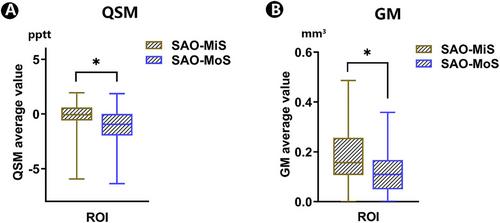Combining Quantitative Susceptibility Mapping With the Gray Matter Volume to Predict Neurological Deficits in Patients With Small Artery Occlusion
Abstract
Background
Currently, there is still a lack of valuable neuroimaging markers to assess the clinical severity of stroke patients with small artery occlusion (SAO). Quantitative susceptibility mapping (QSM) is a quantitative processing method for neuroradiological diagnostics. Gray matter (GM) volume changes in stroke patients are also proved to be associated with neurological deficits. This study aims to explore the predictive value of QSM and GM volume in neurological deficits of patients with SAO.
Methods
As neurological deficits, the National Institutes of Health Stroke Scale (NIHSS) was used. Sixty-six SAO participants within 24 h of first onset were enrolled and divided into mild and moderate groups based on NIHSS. QSM values of infarct area and GM volume were calculated from magnetic resonance imaging (MRI) data. Two-sample t-tests were used to compare differences in QSM value and GM volume between the two groups, and the diagnostic efficacy of the combination of QSM value and GM volume was evaluated.
Results
The results revealed both the QSM value and GM volume within the infarct area of the moderate group were lower compared to the mild group. Moderate group exhibited lower GM volume in some specific gyrus compared with mild group in the case of voxel-wise GM volume on whole-brain voxel level. The support vector machine (SVM) classifier's analysis showed a high power for the combination of QSM value, GM volume within the infarct area, and voxel-wise GM volume.
Conclusion
Our research first reported the combination of QSM value, GM volume within the infarct area, and voxel-wise GM volume could be used to predict neurological impairment of patients with SAO, which provides new insights for further understanding the SAO stroke.


 求助内容:
求助内容: 应助结果提醒方式:
应助结果提醒方式:


